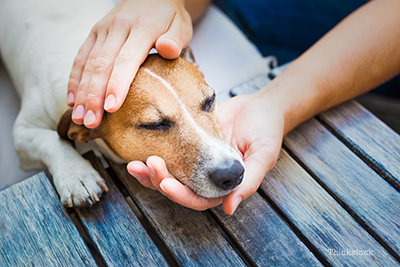
Dr. Jeff Werber is an Emmy Award-winning, nationally renowned veterinarian and former president of the Association of Veterinary Communicators. For more from Dr. Werber, find him on Facebook or on his website at www.drjeff.com.
So when is that “problem” really serious? When should you panic and take your pet to your veterinarian immediately? As a general practitioner who fields phone calls from anxious clients on a very regular basis, I thought it would be a good idea to share with you some guidelines to help ease your minds (or not), and help you answer these questions. Mind you, from experience, I’d venture to say that 80-85% of “emergencies,” aren’t!
That being said, let’s talk about a few of the “common” complaints:
Vomiting/Diarrhea
A very large proportion of calls are for gastrointestinal problems. If your dog starts to vomit, but is still acting totally normal, and WANTS to eat or drink, I’m usually less concerned. As a matter of fact, though these dogs want to eat or drink, it is best not to let them. Often, once that stomach goes through the rigors and smooth muscular contractions associated with vomiting, not to mention the potential irritation to the stomach wall itself, it is primed for more vomiting. So, anything that goes into that stomach, even something as benign as water, which will stretch that stomach wall, and can easily induce more vomiting. Simply said, vomiting breeds vomiting. What we recommend is to keep these dogs without food for at least 12 hours, and instead of allowing them access to water, place a few ice cubes or ice chips in his or her water bowl in order to minimize the amount of water that can be ingested at one time. This will prevent the stomach from stretching. Now, if the vomiting continues despite all of this, or your dog seems to be becoming more depressed or listless, begins to dry-heave frequently, or you note his or her abdomen beginning to expand and tighten up, then it is definitely time to call your veterinarian or a local emergency hospital.
As far as diarrhea is concerned, we typically see two types—small intestinal and large intestinal. Small intestinal diarrhea is typically characterized by very loose or watery stool. These dogs are often more depressed or lethargic and seem “sick.” In contrast, large intestinal diarrhea is often more soft or “mushy,” more like “cow patties,” and can even appear to be encased in mucus or even frank, or red, blood. Dogs with large intestinal diarrhea are more often than not still happy and animated. Though this stool with blood may look scary, it’s usually not something to panic about.
If dogs with the very watery, small intestinal diarrhea, are still acting okay, and will eat, we recommend feeding them a very bland diet, say boiled white meat chicken, or low-fat cottage cheese, mixed with white rice, mashed potatoes, or pasta. This is fairly easy to digest and will act to help bind them. Dogs with the large intestinal soft/mushy stool will usually still want to eat, but should be fed bland food high in fiber. The bland chicken or cottage cheese is still appropriate, but for the carbohydrates you want to feed high fiber, like cooked oatmeal, bran or bran flakes (no Raisin Bran, of course), or canned pumpkin. You can even add some psyllium powder.
Again, if the symptoms persist past a few days, actually worsen, or if your dog’s general attitude, energy, or appetite diminish, it’s time to see your veterinarian.
Limping
This is also a common complaint, and seems to freak pet parents out a lot. Most causes of “limping,” even those that appear suddenly, are NOT true emergencies or reasons to panic. The causes are many, ranging from injury (bone or soft tissue), congenital growth-related conditions, or, in less common instances (and more prevalent in much older dogs), cancer. In cases where your dog is totally “non-weight bearing,” we are often a bit more concerned, but again, unless you witnessed your dog being in a major accident (like being hit by a car), being in a serious dog fight, or falling from a significant height, where there is obvious soft tissue damage, or a strong likelihood of a broken bone, you can probably wait a day, or at least to the next morning, to see your regular veterinarian.
If a soft tissue strain is likely, you can try applying an ice pack or wrap the limb in a cold towel to help relieve any inflammation. In a pinch, you can give your dog an aspirin or Ascriptin (one baby aspirin per 15 to 20 lbs of body weight, or one adult aspirin or Ascriptin per 60 to 80 lbs of body weight) once! Do not use any Acetaminophen or Ibuprofen without first consulting your veterinarian! Likewise, if you think you need to use a second dose of aspirin because the limping has not resolved at all, we recommend you consult your veterinarian first. If signs of limping or limb pain persist with no resolve within the first 24 to 36 hours, then it is time to visit your veterinarian.
In part II of this article, we will cover the problems of Shivering/Shaking, and Weakness/Lethargy.
If you have any questions or concerns, you should always visit or call your veterinarian – they are your best resource to ensure the health and well-being of your pets.
